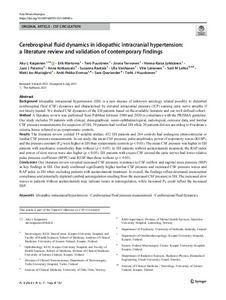Cerebrospinal fluid dynamics in idiopathic intracranial hypertension: a literature review and validation of contemporary findings
Paterno Jussi J; Elomaa Antti-Pekka; Iso-Mustajärvi Matti; Tervonen Joona; Jyrkkänen Henna-Kaisa; Puustinen Tero; Lehto Soili M; Martoma Erik; Leinonen Ville; Rantala Susanna; Kaipainen Aku L; Kotkansalo Anna; Qvarlander Sara; Vanhanen Ulla; Huuskonen Terhi J
https://urn.fi/URN:NBN:fi-fe2021093048284
Tiivistelmä
Background Idiopathic intracranial hypertension (IIH) is a rare disease of unknown aetiology related possibly to disturbed cerebrospinal fluid (CSF) dynamics and characterised by elevated intracranial pressure (ICP) causing optic nerve atrophy if not timely treated. We studied CSF dynamics of the IIH patients based on the available literature and our well-defined cohort.
Method A literature review was performed from PubMed between 1980 and 2020 in compliance with the PRISMA guideline. Our study includes 59 patients with clinical, demographical, neuro-ophthalmological, radiological, outcome data, and lumbar CSF pressure measurements for suspicion of IIH; 39 patients had verified IIH while 20 patients did not according to Friedman's criteria, hence referred to as symptomatic controls.
Results The literature review yielded 19 suitable studies; 452 IIH patients and 264 controls had undergone intraventricular or lumbar CSF pressure measurements. In our study, the mean CSF pressure, pulse amplitudes, power of respiratory waves (RESP), and the pressure constant (P0) were higher in IIH than symptomatic controls (p < 0.01). The mean CSF pressure was higher in IIH patients with psychiatric comorbidity than without (p < 0.05). In IIH patients without acetazolamide treatment, the RAP index and power of slow waves were also higher (p < 0.05). IIH patients with excess CSF around the optic nerves had lower relative pulse pressure coefficient (RPPC) and RESP than those without (p < 0.05).
Conclusions Our literature review revealed increased CSF pressure, resistance to CSF outflow and sagittal sinus pressure (SSP) as key findings in IIH. Our study confirmed significantly higher lumbar CSF pressure and increased CSF pressure waves and RAP index in IIH when excluding patients with acetazolamide treatment. In overall, the findings reflect decreased craniospinal compliance and potentially depleted cerebral autoregulation resulting from the increased CSF pressure in IIH. The increased slow waves in patients without acetazolamide may indicate issues in autoregulation, while increased P0 could reflect the increased SSP.
Kokoelmat
- Rinnakkaistallenteet [19248]
